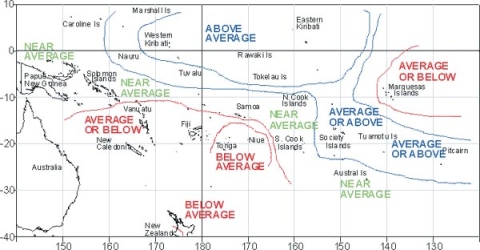Rainfall outlook for January to March 2003
Above average or average rainfall in equatorial latitudes from west to east and Society and Pitcairn Island.
Below average or average rainfall from Vanuatu, New Caledonia, trending east to Niue and the Marquesas Islands.
Mainly average rainfall expected elsewhere.
Enchanced convection in the equatorial Pacific region is expected to continue from January till March 2003, resulting in an increased likelihood of above average rainfall in both Western and Eastern Kiribati and Tokelau.
Rainfall is expected to be average or above average in Tuvalu, Society Islands and Pitcairn Island. A tendency for below average or average rainfall from Vanuatu, New Caledonia, trending east to Niue and the Marquesas Islands. Near average rainfall is likely elsewhere.
The forecast model skills for this outlook are generally moderate or high for most countries in the region.
Rainfall outlook map for January to March 2003

Tropical cyclone update
The tropical cyclone season is now well underway, with two cyclones, 'Yolanda and Zoe' (one less than the normal ENSO frequency for the November – December period) having occurred so far this season.
'Yolanda' developed over southern Tuvalu on 1st December, and then tracked south, passing east of Fiji on the 4th, and then southeast over southern Tonga on the 5th. Maximum sustained winds reached 74 km/h, with heavy rainfall. Fortunately no damage was caused by this event.
'Zoe' formed on 24th December, also over southern Tuvalu, and then tracked west to affect the Solomon Islands from the 28th through 30th. The cyclone tracked southeast to pass between Vanuatu and Fiji over the 30th and 31st.
Probabilities of rainfall departures from average
Broad-scale rainfall patterns and anomalies in the southern tropical Pacific area are estimated from the state of large-scale regional climate factors, such as La Niña or El Niño, their effect on the South Pacific and Tropical Convergence Zones, surface and sub-surface sea temperatures, and computer models of the global climate.
Rainfall estimates for the next three months for Pacific Islands are given in the adjacent table. The tercile probabilities (e.g. 20:30:50) are derived from the interpretation of several global climate models. They correspond to the odds of the observed rainfall being in the lowest (driest) one third of the rainfall distribution, the middle one third, or the highest (wettest) one third of the distribution. On the long-term average, rainfall is equally likely (33% chance) in any tercile.
The probabilities shown express the expected shift in the distribution from the long-term average, based on predictions of oceanic and atmospheric conditions. The amount of inter-model forecast consistency is indicated by the levels of confidence expressed in the table.
| Island Group | Rainfall Outlook | Confidence in the Outlook | |
|---|---|---|---|
| Western Kiribati | 15:20:65 | (Above) | High |
| Eastern Kiribati | 15:20:65 | (Above) | High |
| Tokelau | 20:30:50 | (Above) | Moderate |
| Tuvalu | 20:40:40 | (Average or above average) | Moderate |
| Society Island | 20:40:40 | (Average or above average) | Moderate |
| Pitcairn Island | 15:45:40 | (Average or above average) | Moderate |
| Papua New Guinea | 25:50:25 | (Near average) | Low |
| Solomon Islands | 25:50:25 | (Near average) | Moderate |
| Wallis & Futuna | 20:45:35 | (Near average) | Moderate |
| Samoa | 20:60:20 | (Near average) | Moderate |
| Northern Cook Islands | 20:50:30 | (Near average) | Moderate |
| Southern Cook Islands | 35:45:20 | (Near average) | Moderate |
| Austral Islands | 25:50:25 | (Near average) | Moderate |
| Vanuatu | 40:50:10 | (Average or below average) | High |
| New Caledonia | 45:40:15 | (Average or below average) | Moderate |
| Fiji | 45:40:15 | (Average or below average) | High |
| Maquesas | 45:40:15 | (Average or below average) | Moderate |
| Tonga | 50:30:20 | (Below averge) | High |
| Niue | 50:30:20 | (Below average) | Moderate – high |
Rainfall outcomes as estimated from models and historical records. The third column indicates the probability of bottom (below), middle (average) or top (above) tercile rainfall, where a percentage is given. The rainfall outlook (second column) is subjectively estimated from the probabilities of bottom, middle and top terciles.
